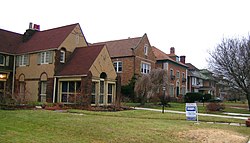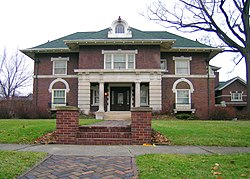Boston-Edison Historic District
|
Boston–Edison Historic District
|
|

Homes on West Boston Boulevard
|
|
| Location | Bounded by Edison Ave., Woodward Ave., Linwood Ave., and W. Boston Blvd. Detroit, Michigan United States |
|---|---|
| Coordinates | 42°22′54″N 83°5′50″W / 42.38167°N 83.09722°WCoordinates: 42°22′54″N 83°5′50″W / 42.38167°N 83.09722°W |
| Area | 256 acres (104 ha) |
| Architectural style | Colonial Revival, Late 19th and Early 20th Century American Movements, Late 19th and 20th Century Revivals |
| NRHP Reference # | 75000965 |
| Significant dates | |
| Added to NRHP | September 5, 1975 |
| Designated MSHS | December 11, 1973 |
|
Henry Ford House
|
|
 |
|
| Part of | Boston–Edison Historic District (#75000965) |
|---|---|
| Designated MSHS | July 17, 1986 |
The Boston–Edison Historic District is a historic neighborhood located in the geographic center of Detroit, Michigan. It consists of over 900 homes built on four east/west streets: West Boston Boulevard, Chicago Boulevard, Longfellow Avenue, and Edison Avenue, stretching from Woodward Avenue on the east to Linwood Avenue on the west. It is one of the largest residential historic districts in the nation. It is surrounded by Sacred Heart Major Seminary to the west, the Arden Park-East Boston Historic District and the Cathedral of the Most Blessed Sacrament to the east, and the Atkinson Avenue Historic District to the south. The district was designated a Michigan State Historic Site in 1973 and listed on the National Register of Historic Places in 1975.
A substantial number of prominent Detroiters have lived in the neighborhood. Notable residents have included labor leader Walter P. Reuther, Rabbi Morris Adler, Detroit Tigers Harry Heilmann and Dizzy Trout, Michigan Supreme Court justices Franz C. Kuhn and Henry Butzel, U.S. Representative Vincent M. Brennan, Michigan governor Harry Kelly, boxer Joe Louis, druggist Sidney Barthwell, Congressman Charles C. Diggs, Jr., Motown record label founder Berry Gordy, Detroit Tiger Willie Horton, and dentist and pioneering WCHB radio station owner Wendell F. Cox.
...
Wikipedia
